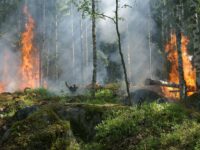As we grapple with the consequences of anthropogenic climate change, some scientists and researchers have tried to nominalize the cause of today’s environmental degradation. The term “Anthropocene” has been used to emphasize humanity’s impact on the environment, suggesting that humans are the major force of environmental change in this geological epoch. In 2016, the Anthropocene Working Group made a binding vote to treat the Anthropocene as a formal chronostratigraphic unit, but its parent organization, the International Commission on Stratigraphy — which is responsible for establishing the geological time scale — has yet to formally recognize the Anthropocene as the current epoch and still refers to the present as the Holocene, the epoch proceeding the last ice age. Although the Anthropocene is unofficial, anthropologists and literary scholars have taken an interest in playing with periodic designations to understand the origins of our current environmental crisis.
The start of the Anthropocene is contested, ranging from the invention of agriculture 12,000 to 15,000 years ago to the Industrial Revolution in the 18th and 19th centuries. However, in the context of climate change, scientists typically refer to the latter as the start, as most of the instrumentally measured data sets of global temperature begin around 1850. Furthermore, the data show that after the Industrial Revolution, Earth’s average global temperature increased drastically throughout the 20th century.
If we view the designation of the Anthropocene as a way to understand the climate crisis, then it follows that we should understand how and why humans began to and continue to affect Earth’s climate, so we can address the processes that harm our environment. By entertaining this logic, anthropologists Donna Haraway and Anna Tsing coined the term “Plantationocene” to more accurately pinpoint the beginning of the ideological and socioeconomic systems that have engendered our current environmental degradation. They argue that the term Anthropocene is too broad and does not address the root of climate change, which is capitalism. Humans are not all equally responsible for climate change: The Industrial Revolution itself only refers to the developments of the economies of Europe and the United States, and the famous 2017 “Carbon Majors Report” by the CDP, a global nonprofit supporting the disclosure of data on companies and governments’ impact on the climate, revealed that 100 companies are responsible for 71 percent of carbon emissions since 1988. These facts concentrate the blame onto the Western world and corporations specifically. While the term “Capitalocene” has been suggested to reflect this, Haraway and Tsing assert that the logic of capitalism can be located back to the creation of the plantation — hence, Plantationocene.
The theoretical conception of capitalism arose in Adam Smith’s writings in the 18th century. At a basic level, capitalism is the private ownership of the means of production in a market economy. Private individuals control the resources and labor needed to produce goods and services, and these individuals, capitalists, are driven by the profit motive — that is, they seek to maximize profit, which is the economic value produced after accounting for the costs of materials and labor.
This same logic of working on profit margins emerged in practice on plantations in the 17th century. Take the example of Barbados: During the 17th century, the British set up colonies and sugar plantations on the island. Plantation owners used indentured servants and enslaved people to grow and harvest sugarcane on the island; enslavers bought land, resources, and labor to transform the sugarcane plant into sugar and sell it as a commodity. Private landowners on the island maximized profits by exclusively growing sugarcane and transitioning from using indentured servants to primarily slave labor.
Plantation owners opted for slave labor because it was more cost effective to subject Black people to work and to keep their children as slaves than to import labor from indentured servants, who would ultimately be freed after a set period of time. Sugar became such a profitable commodity that it was more cost effective to import food from the New England colonies than it was to grow food on the island. Therefore, Barbados’ arable land was only used to grow sugar, resulting in a sugar monoculture that was emulated across colonies. Scientists have long argued that monoculturing is an unsustainable agricultural practice that results in disease and pest outbreaks, soil degradation, and ecological instability due to the reduction in biodiversity and consequent changes in the biogeochemical cycles of the local environment. Just like the transition to slave labor, the logic of crop production justifies exploitation and degradation to reach the end of maximizing profits.
The structure of the plantation and its society, with enslavers who exploited natural resources and enslaved labor to become wealthy, precisely reflects capitalism’s structure: an elite class owns most of the wealth and uses other people’s labor to make money. Today, we see how corporations harm the environment, whether by polluting water sources, lobbying for and building new oil pipelines in protected wilderness areas, or clearing forests for land development. The Plantationocene reminds us that the consequences we see today aren’t new but logical conclusions to a system set in motion centuries ago.
Beyond the economic effects of capitalism and the plantation, the term also emphasizes the racial nature of this exploitation. Communities of color are disproportionately harmed by environmental degradation: A September 2021 EPA report found that, at 2 degrees Celsius of global warming, Black Americans are significantly more likely to currently live in areas with the highest projected increases in childhood asthma diagnoses and extreme temperature related deaths. Even though we’ve moved past racialized chattel slavery, the consequences of the socioeconomic systems that constructed plantation society still reverberate in the modern day.
In terms of solving climate change, that means that we have to look at how the plantation and capitalist systems that have built society today are not only the foundation of our world but also part of the processes that continue to shape it. Over the past few years, there have been more public reckonings with systemic racism and the economic inequalities embedded in our society, but these problems have existed for centuries. These conversations have opened space for new ways of understanding our world and the problems in it, with new vocabularies to make sense of things. The designation of the Plantationocene is no different. It’s a diagnosis. It frames the conversation around our problems, so we can look in the right places for the right solutions. In February 2022, professor of economics Hoesung Lee, the chair of the Intergovernmental Panel on Climate Change, ended his remarks at a press conference by saying, “Half measures are no longer an option.” If we have a system whose logic condones the exploitation and extraction of resources and people — and whose logical conclusion has resulted in our current environmental crisis — then any solution within that logic will always be a half measure.
Source:
Ethnos (2015). DOI: 10.1080/00141844.2015.1105838
Image courtesy of Flickr






